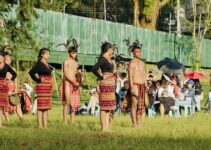You'll discover the powerful stories of the 3 Best Indigenous Rights Protests and Movements Revealed. These movements have reshaped history and ignited change in the fight for indigenous rights. From the Idle No More Movement's grassroots activism to the Oka Crisis's stand against land encroachment, and the recent Wet'suwet'en Protests' defense of territorial sovereignty, these protests have sparked national and international attention. Get ready to delve into the inspiring resilience and determination of indigenous communities as they stand up for their rights.
Key Takeaways
- Grassroots activism energizes Indigenous communities and advocates for Indigenous sovereignty and environmental protection.
- Indigenous rights protests like the Idle No More Movement and the Wet'suwet'en Protests have fostered a renewed sense of empowerment and unity among Indigenous peoples.
- These movements highlight the ongoing struggles and resilience of Indigenous communities, shedding light on systemic injustices and raising awareness of environmental challenges.
- The protests emphasize the need to safeguard lands for future generations, assert land rights, and call for meaningful consultation and consent in major development projects.
Idle No More Movement
If you want to understand the impact of the Idle No More movement, look beyond the headlines and delve into the grassroots activism that has energized Indigenous communities across North America. The movement represents a powerful call for Indigenous sovereignty and environmental protection. It has sparked a renewed sense of empowerment and unity among Indigenous peoples, advocating for their inherent right to self-governance and the protection of their lands and resources. Through peaceful protests, teach-ins, and social media campaigns, Idle No More has brought attention to the critical issues facing Indigenous communities and their ongoing resistance against environmental degradation and governmental encroachment.
As you explore the Idle No More movement, it's important to recognize its significance in shedding light on the interconnectedness of Indigenous sovereignty and environmental protection. The movement has highlighted the deep connection between Indigenous peoples and their traditional territories, emphasizing the need to safeguard these lands for future generations. This connection serves as a crucial foundation for understanding the ongoing struggles and resilience of Indigenous communities in the face of environmental challenges and systemic injustices.
This movement has been pivotal in shaping the discourse around Indigenous rights and environmental activism, laying the groundwork for future advocacy and awareness. As we transition to discussing the 'Oka Crisis', it's essential to acknowledge the enduring impact of Idle No More in mobilizing Indigenous voices and allies in the pursuit of justice and equality.
Oka Crisis
The Idle No More movement has set the stage for understanding the Oka Crisis, a significant event in Indigenous rights activism. The Oka Crisis, which took place in 1990, stemmed from a land dispute between the Mohawk people of Kanesatake and the town of Oka in Quebec, Canada. The crisis was a pivotal moment in the struggle for indigenous sovereignty and self-determination. It began when the town of Oka announced plans to expand a golf course onto land that the Mohawk considered to be part of their sacred territory.
In response to the proposed expansion, the Mohawk people set up blockades to prevent construction, leading to a tense standoff with the local authorities. The crisis escalated, and the Canadian government eventually deployed the military to intervene. The government's response to the Oka Crisis was widely criticized, and it sparked nationwide protests in support of Indigenous land rights and sovereignty. The Oka Crisis serves as a poignant reminder of the ongoing challenges faced by Indigenous communities in their fight for autonomy and recognition of their traditional territories.
Wet'suwet'en Protests
You should examine the ongoing Wet'suwet'en protests, which have garnered attention for their resistance against the construction of a natural gas pipeline through their traditional territory in British Columbia, Canada. The protests are rooted in the Wet'suwet'en people's assertion of their land rights and their commitment to environmental protection. The conflict revolves around the construction of the Coastal GasLink pipeline, which the Wet'suwet'en leaders argue infringes upon their sovereignty and poses significant environmental risks to their ancestral lands.
The Wet'suwet'en protests have sparked a national conversation about the rights of Indigenous communities and the balance between economic development and environmental conservation. This movement has drawn widespread support from various Indigenous groups, environmental activists, and concerned citizens across Canada, leading to solidarity protests and demonstrations in different parts of the country.
The dispute highlights the broader issue of Indigenous land rights and the need for meaningful consultation and consent in major development projects impacting Indigenous territories. It also underscores the importance of prioritizing environmental protection and sustainability in these ventures. The ongoing resistance by the Wet'suwet'en people serves as a powerful reminder of the enduring struggle for Indigenous rights and the preservation of natural landscapes.
Frequently Asked Questions
How Do the Idle No More Movement, Oka Crisis, and Wet'suwet'en Protests Compare in Terms of Their Impact on Indigenous Rights in Canada?
When comparing the Idle No More movement, Oka Crisis, and Wet'suwet'en protests in terms of their impact on Indigenous rights in Canada, it's important to consider their historical significance. Each event brought attention to different aspects of Indigenous rights and sovereignty. The Oka Crisis highlighted land disputes, while Idle No More focused on environmental protection. The Wet'suwet'en protests raised concerns about resource development on Indigenous lands. Each had a significant impact on Indigenous rights in Canada.
What Are Some of the Key Similarities and Differences Between the Tactics and Strategies Used by the Idle No More Movement, Oka Crisis, and Wet'suwet'en Protests?
When comparing the tactics and strategies of the Idle No More movement, Oka Crisis, and Wet'suwet'en protests, you'll notice both similarities and differences. Each movement used peaceful demonstrations and direct action to raise awareness and demand change, but the specific approaches and historical contexts varied. While Idle No More focused on grassroots organizing and social media, the Oka Crisis centered around land disputes, and the Wet'suwet'en protests emphasized sovereignty and resource development.
How Have the Outcomes of the Idle No More Movement, Oka Crisis, and Wet'suwet'en Protests Influenced the Broader Indigenous Rights Movement in Canada?
The outcomes of the Idle No More movement, Oka Crisis, and Wet'suwet'en protests have significantly impacted indigenous activism and fostered greater indigenous solidarity in Canada. These events have sparked a wave of heightened awareness and mobilization, leading to increased support for indigenous rights and issues. The solidarity and activism resulting from these movements have contributed to a more unified and powerful indigenous rights movement in Canada.
What Role Did Social Media and Digital Activism Play in the Idle No More Movement, Oka Crisis, and Wet'suwet'en Protests?
Social media and digital activism played a crucial role in the Idle No More movement, Oka crisis, and Wet'suwet'en protests. These platforms provided a space for Indigenous voices to be heard, mobilized supporters, and raised awareness about Indigenous rights issues. They facilitated the rapid spread of information and enabled communities to organize and coordinate actions. The impact of social media on the Indigenous rights movement has been significant, amplifying the reach and influence of these protests.
How Have the Idle No More Movement, Oka Crisis, and Wet'suwet'en Protests Impacted the Relationship Between Indigenous Communities and the Canadian Government?
You've seen how the Idle No More movement, Oka crisis, and Wet'suwet'en protests have shaken up the relationship between Indigenous communities and the Canadian government. Reconciliation efforts have been impacted, with the government's responses facing scrutiny. These movements have empowered Indigenous communities, shedding light on legal implications and sparking conversations about the need for meaningful change in the relationship between Indigenous peoples and the government.
Conclusion
You've just learned about three powerful indigenous rights movements that have made a significant impact. Take the Wet'suwet'en protests, for example. Imagine being forcibly removed from your ancestral lands, feeling the weight of injustice and betrayal. These movements remind us of the ongoing struggle for indigenous rights and the importance of standing in solidarity with marginalized communities. It's a call to action to support and amplify indigenous voices in the fight for justice.



